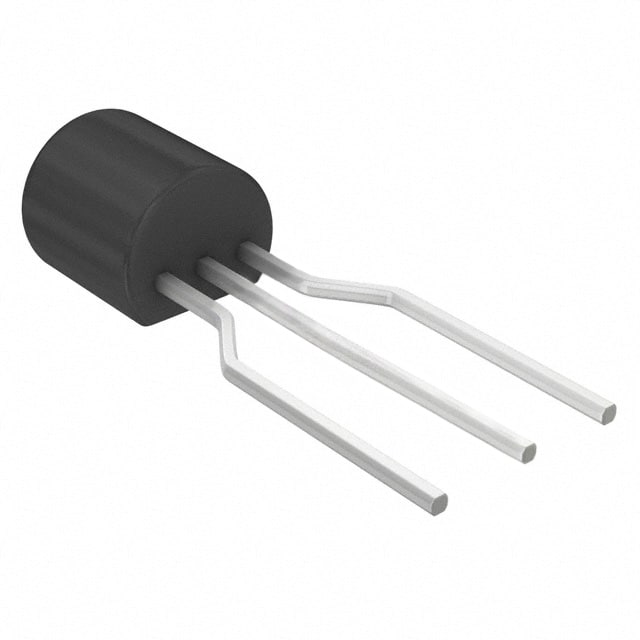Подробную информацию о продукте см. в характеристиках.

2N4403TFR
Product Overview
The 2N4403TFR belongs to the category of small signal transistors and is commonly used in electronic circuits for amplification, switching, and regulation purposes. This transistor exhibits characteristics such as high voltage capability, low noise, and low power consumption. It is typically available in a TO-92 package and is widely used in various electronic applications due to its versatility and reliability.
Basic Information
- Category: Small Signal Transistor
- Use: Amplification, Switching, Regulation
- Characteristics: High Voltage Capability, Low Noise, Low Power Consumption
- Package: TO-92
- Essence: Versatile and Reliable
- Packaging/Quantity: Typically available in reels or tubes containing multiple units
Specifications
- Maximum Collector-Emitter Voltage (Vce): 40V
- Maximum Collector-Base Voltage (Vcb): 60V
- Maximum Emitter-Base Voltage (Veb): 6V
- Continuous Collector Current (Ic): 600mA
- Power Dissipation (Pd): 625mW
- Transition Frequency (ft): 250MHz
- Operating Temperature Range: -55°C to 150°C
Detailed Pin Configuration
The 2N4403TFR transistor has three pins: the collector (C), base (B), and emitter (E). The pin configuration is as follows: - Collector (C): Pin 1 - Base (B): Pin 2 - Emitter (E): Pin 3
Functional Features
The 2N4403TFR transistor offers the following functional features: - High voltage capability allows for use in various electronic circuits - Low noise characteristics make it suitable for audio applications - Low power consumption contributes to energy-efficient designs
Advantages and Disadvantages
Advantages
- Versatile application in amplification, switching, and regulation circuits
- Reliable performance in diverse electronic applications
- Low noise operation for high-quality audio applications
Disadvantages
- Limited maximum collector current compared to some higher-power transistors
- Moderate transition frequency may limit high-frequency applications
Working Principles
The 2N4403TFR operates based on the principles of bipolar junction transistors (BJTs). When a small current flows into the base terminal, it controls a larger current flow between the collector and emitter terminals. This amplification and control of current make it suitable for various electronic circuit functions.
Detailed Application Field Plans
The 2N4403TFR finds extensive use in the following application fields: - Audio Amplification Circuits - Switching Circuits - Voltage Regulation Circuits - Oscillator Circuits - Sensor Interface Circuits
Detailed and Complete Alternative Models
Some alternative models to the 2N4403TFR include: - BC547 - 2N3904 - 2N2222 - BC548 - 2N4401
In conclusion, the 2N4403TFR transistor is a versatile and reliable component that finds widespread use in electronic circuits for amplification, switching, and regulation. Its high voltage capability, low noise characteristics, and low power consumption make it an essential building block in various electronic applications.
Word Count: 464
Перечислите 10 распространенных вопросов и ответов, связанных с применением 2N4403TFR в технических решениях.
What is the 2N4403TFR transistor used for?
- The 2N4403TFR is a general-purpose PNP transistor commonly used for amplification and switching applications in electronic circuits.
What are the key specifications of the 2N4403TFR transistor?
- The 2N4403TFR has a maximum collector current (Ic) of 600mA, a maximum collector-base voltage (Vcbo) of -40V, and a maximum emitter-base voltage (Vebo) of -5V.
How can I use the 2N4403TFR in an amplifier circuit?
- The 2N4403TFR can be used as a small-signal amplifier in audio or other low-power applications by configuring it in common emitter or common base configurations.
Can the 2N4403TFR be used for switching applications?
- Yes, the 2N4403TFR can be used for low-power switching applications due to its moderate current and voltage ratings.
What are the typical operating conditions for the 2N4403TFR?
- The 2N4403TFR is typically operated within a temperature range of -55°C to 150°C and is suitable for use in various electronic devices and equipment.
Are there any alternative transistors that can be used in place of the 2N4403TFR?
- Yes, alternatives include the 2N3906, BC557, and BC327, which have similar characteristics and can be substituted depending on the specific application requirements.
What are the pin configurations of the 2N4403TFR transistor?
- The 2N4403TFR transistor typically has three pins: the emitter, base, and collector, with the emitter being connected to the most negative voltage in PNP configurations.
Can the 2N4403TFR be used in high-frequency applications?
- The 2N4403TFR is not designed for high-frequency applications due to its moderate transition frequency and is better suited for low to moderate frequency designs.
What are some common pitfalls to avoid when using the 2N4403TFR in a circuit?
- It's important to avoid exceeding the maximum ratings for current, voltage, and power dissipation to prevent damage to the transistor. Additionally, proper biasing and thermal considerations should be taken into account.
Where can I find detailed datasheets and application notes for the 2N4403TFR?
- Datasheets and application notes for the 2N4403TFR can be found on semiconductor manufacturer websites, distributor platforms, and electronics component databases.

